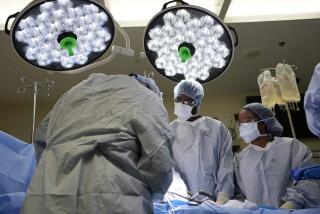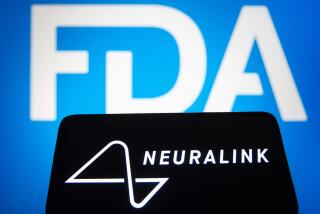First Such Surgery in County : Parkinson’s Sufferer to Receive Brain Graft
Neurosurgeons at UC Irvine Medical Center plan to graft cells from a woman’s adrenal gland to her brain Friday in the first operation of its kind in Orange County on a patient with Parkinson’s disease.
The scheduled surgery, the latest of more than 50 such operations by neurosurgeons around the world, is considered “investigational.” The UCI doctors performing the procedure say they cannot promise the patient that her transplanted cells will grow in the brain or that the four- to five-hour operation--which involves major abdominal surgery as well as the brain procedure--will help her.
The UCI surgical team hopes to perform a total of five of the procedures, which have been criticized by some medical professionals on the grounds that they are highly experimental and sometimes have not proven successful. UCI’s human subject protection committee, however, recently reviewed and approved the operations.
Dr. Leslie Cahan, 41, a UCI professor of neurosurgery who is heading up the transplant team with Dr. Ronald S. Young, chief of UCI’s division of neurosurgery, is hoping the grafted cells will secrete chemicals that will reverse the course of the patient’s disease.
Patients with Parkinson’s disease are deficient in a chemical called dopamine that is normally produced in the brain. Most of the estimated 1.5 million U.S. sufferers of Parkinson’s disease were older than 50 when they contracted the disease, according to medical authorities.
To relieve the slurred speech, slowed body movement and tremors that often characterize Parkinson’s patients, they must take a drug called L-Dopa, a pharmaceutical equivalent of dopamine.
But for many patients, including Friday’s surgery candidate, doctors say the medicine has gradually become less effective. Over the last several years, the woman’s symptoms have gradually worsened. Cahan said he was hopeful that if the brain graft works, the adrenal cells in the brain would either secrete dopamine or related chemicals, or would stimulate other brain cells to produce dopamine again. If that occurred, Cahan said, the woman’s symptoms might lessen.
Still, he cautioned, “it’s not fair to say that this operation is going to be the cure-all for Parkinson’s disease.” Neurosurgeons are not yet sure whether the graft itself, or the trauma of the surgery, somehow re-stimulates the brain. They also are not sure whether the surgery will produce long-term improvements, Cahan and other experts said.
The operation, sometimes known as a “brain transplant,” involves removing the woman’s left adrenal gland, located near the kidney. Surgeons, using a microscope, then take cells from part of the adrenal gland. Those cells are then injected into a small cavity deep inside the brain, an area known as the ventrical.
But, Cahan noted, similar investigational surgeries performed over the last 1 1/2 years in Mexico City have resulted in significant improvements in mobility for Parkinson’s patients.
In the Mexico City cases, some of which were reported in the April 2 issue of the New England Journal of Medicine, doctors reported a restoration of approximately “two-thirds” of their patients’ mobility after operations on about 30 patients, Cahan said.
Although this may be positive, it’s “not 100% improvement,” he said. “It’s hard to know what that does mean: ‘two-thirds less Parkinson’s than before.’ ”
Friday’s operation is to be the first of five such operations that will attempt to replicate the Mexico City results, Cahan said.
As in the Mexico City operations, a team of psychiatrists will perform a radioactive scan of the patient’s brain that is known as a PETSCAN, or positron emission tomographic scan. Psychiatrist Monte Buchsbaum performed a pre-operative PETSCAN on Dec. 2 and expects to perform another scan 30 to 60 days after the transplant to look for changes in the brain’s metabolism.
Noting ethical concerns within the medical profession about the operation, Cahan said he wanted to perform the graft on patients who were severely, rather than moderately, disabled by Parkinson’s because the operation is dangerous and because of the uncertain results from the procedure to date. “In my own mind, the whole operation still has to have a big question about it,” he said.
Cahan said the woman who will undergo the surgery Friday is in her early 50s and has had Parkinson’s disease for several years. The patient, who asked that her name be withheld, can perform some household tasks, Cahan said, but her speech is slurred, and she can only walk and move “in very slow motion.” Despite the L-Dopa medication, her condition “is worsening gradually,” he said.
Over the years, human brain grafts have produced mixed results. The first such transplants were performed as long ago as 1890. But “establishment” scientists insisted the technique was unworkable--and worse, immoral--prompting a halt to all such work. Most physicians at the time considered the brain “sacrosanct” and different from other parts of the body.
Virtually no attempts were made to graft brain cells again until the early 1970s, when Swedish doctors began grafting cells in rodents with some initial success.
However, when Swedish doctors at the Karolinska Institutet in Stockholm made the jump from rats to humans, performing the procedure on four Parkinson’s patients, the results were disappointing. They observed only modest improvements, which disappeared within two months.
However, international interest in the procedure was reawakened last April, when Mexican neurosurgeon Ignacio Navarro Madrazo of Centro Medico La Raza in Mexico City and neurobiologist Rene Drucker-Colin of the University of Mexico reported dramatic improvements in two patients.
In their article in the New England Journal of Medicine, they reported that one patient, completely disabled before surgery, was able to speak clearly, dress, bathe and feed himself after the surgery.
Unlike the unsuccessful Swedish researchers, Madrazo had reportedly implanted the cells in a naturally occurring cavity in the brain where they were bathed in nutrients. The Swedish investigators had embedded the adrenal cells deep in the brain where they were not exposed to nutrients and apparently died soon after the surgeries.
Since the April journal report, the Mexico City team has done about 30 more operations with some success, Cahan said Tuesday.
Within two weeks of publication of Drucker-Colin and Madrazo’s work, a team of surgeons from Vanderbilt University in Nashville, Tenn., moved ahead with similar brain-graft surgery. Dr. George Allen, who headed that transplant team, said last week that they have now done 18 such brain grafts. He plans to report his results at a scientific conference in January. But in a preliminary report, presented at the Schmitt Symposium in Rochester, N.Y., last June, Allen reported “some very early changes” on six patients “that suggested there might be improvement.”
However, Allen said Tuesday in a telephone interview that he had no idea “whether that was a placebo effect due to the (trauma of) the transplant, or maybe it was just the natural ups and downs in the patient’s clinical course.”
Cahan said he was aware of Allen’s work and believed it to be very similar to the operations his team plans, but did not know Allen’s results. Cahan said he became interested in the surgery after Drucker-Colin and Madrazo’s journal article, and last month he and neurosurgery chief resident Dr. Jose Rodriguez traveled to Mexico City, where they met with Madrazo, studied his data and observed a transplant operation.
Cahan said the operation also was feasible here because Carl W. Cotman, a renowned UCI professor of psychobiology, has been performing animal studies involving brain transplants for some time.
For now, Cahan said the procedure is scheduled for 7:30 a.m. Friday. But if his patient develops a bad cold, or if the operating room is full, he said he will postpone it.
UCI doctors who are to participate in the surgery are: Cahan, Young and Rodriguez performing the brain surgery; Dr. Kenneth Nudleman, associate professor of neurology, as the team neurologist; psychiatrist Buchsbaum performing the brain scan, and Dr. G. Robert Mason, UCI’s chairman of surgery, performing the abdominal surgery to remove the adrenal gland.
At Western Medical Center in Santa Ana and at Hoag Memorial Hospital Presbyterian in Newport Beach, neurologists suggested that the surgery was too experimental and they would not want to recommend it now for their patients.
Dr. Michael S. Sukoff, chairman of neurosurgery at Western Medical, however, applauded the pioneering effort by the university hospital. But he added that it would be six months to two years before any of his Parkinson’s patients would be a candidate for such a surgery.
“It’s very important surgery--especially if it works. But in terms of utilization now, it’s much too early to recommend that most surgeons perform it,” Sukoff said.
Later, when more about the surgery’s morbidity and effectiveness is known, he might try it, Sukoff said. “But right now I wouldn’t want to treat any of my patients until these variables are sorted out.”






